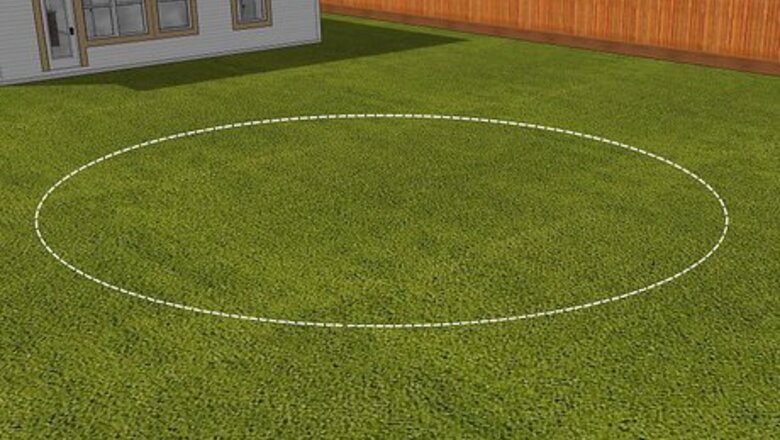
views
Designing and Documenting Your Pool
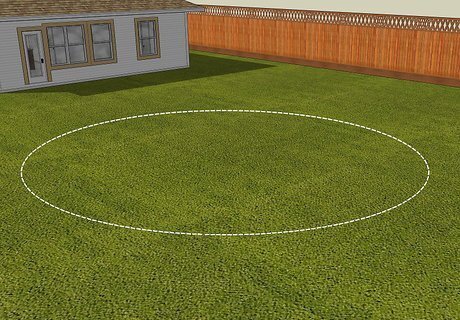
Choose a place to build the pool. Find a place on your property with enough room for the pool. A spacious backyard area is usually the best option. Note any obstacles that will need to be removed, such as trees, rocks, fences, or even utility lines. Removing these obstacles takes additional time and money. Think carefully about what you want out of a pool. Leave space for features like pump systems and diving boards. To estimate the size of these features, calculate the size of your pool or how much water it will hold, then look for suitable products. Underground obstacles like utility lines are difficult to find without digging. Call your local utility companies for advice. Ask them to send a technician to mark the location of your lines. The location you choose affects your pool. Put your pool above a slope so debris doesn’t wash into it during rainy days. Keep it in sunlight to warm the water naturally. Pool contractors look at an element called setback, or how far away your pool has to be from your property line. In California, the required setback is 5 ft (1.5 m).

Sketch a basic design for your pool. Pick up a pencil and a piece of paper, then create the pool you plan on constructing. Settle on the pool’s shape and size. Then, begin planning the features, including pool steps, lighting, and other accessories. Factor in limitations like the yard space you have available to choose the right pool for your situation. An average concrete pool is something like 10 ft × 20 ft (3.0 m × 6.1 m) in size with a depth up to 10 ft (3.0 m). All of these dimensions can be changed depending on your ideal pool. The concrete pool needs to be at least 6 in (15 cm) thick, so widen and deepen the outline as needed to compensate. Keep in mind that each additional feature raises the cost and time commitment of building a pool.
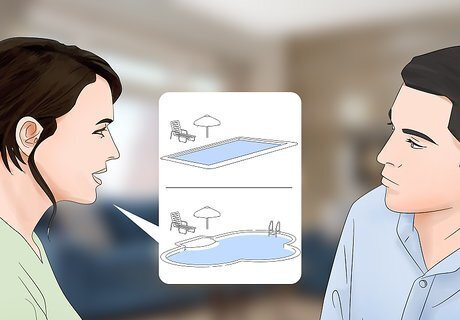
Take your design to a professional pool builder for advice. Search your area for some trustworthy contractors with experience building concrete pools. A good contractor will take a look at your plan and give you advice on how to improve it. Ask to see a valid contractor’s license with pool specialty licensing before hiring anyone. At the very least, you need contractors to approve your design before you can get a building permit. You have to do this even if you plan on building the pool yourself. Look for subcontractors specializing in areas like plumbing and electrical wiring. They can help finalize your design.
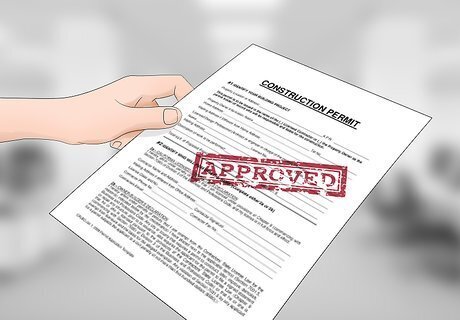
Apply for the building permits required by your local government. Since building a pool involves changing the land and lots of safety concerns, you have to get a permit before construction starts. Head to the building department at your local city hall to apply. Bring your finalized design to show what you plan on constructing. If applicable, consult your neighborhood’s homeowners association guidebook before completing your application. Some places restrict pools. Depending on where you live, you may need to get a separate electrical permit before beginning construction. If you hired a pool builder or subcontractor, ask them for help getting the necessary permits. Many companies handle the application process by default.
Excavating the Pool’s Base
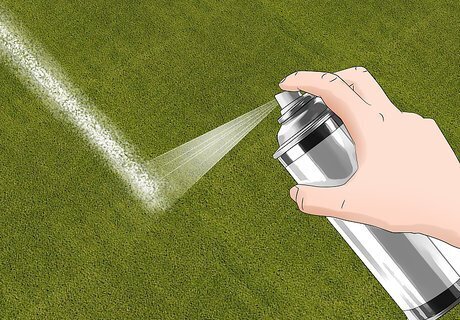
Measure and mark the pool’s dimensions on the ground. Use marking chalk to create a temporary outline for the pool. Spray the chalk directly on the ground. Note the pool’s borders, then the placement of walls, steps, and other accessories that need to be placed during the excavation. Remember to dig out enough space to create the thick slabs of concrete for the pool’s floor and walls.

Dig out the soil to create the basic shape of the pool. The quickest way to do this is with a backhoe. Locate a rental company or hire a subcontractor to get the job done. Set the excavated soil away from the edge of the pool. Use a tape measure or marked measuring sticks to keep track of the pool’s depth. For example, if your pool needs to be 6 ft (1.8 m), cut a 6 ft (1.8 m) pole to use as a reference. Make references for the deep and shallow end if your pool has them. Remember that you can always put dirt back if you dig too far down. Dig out the soil by hand if you can’t get a backhoe. Use a spade or alternative digging tools. Some areas aren’t accessible to heavy equipment and have to be dug out the old-fashioned way. Make sure you have your permit and know about any utility lines in the ground. Hitting a utility line is a big problem. Hire a contractor to take care of any utility lines needing to be moved. The leftover soil can be sold, disposed of by a contractor, or repurposed for other projects, such as for plant beds.
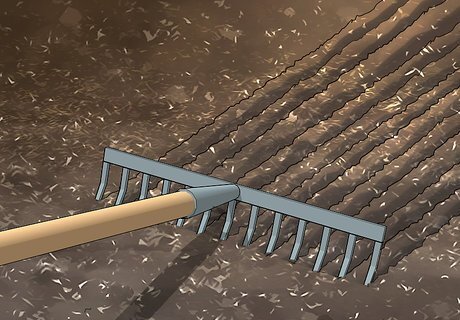
Level the pool’s bottom and walls with a rake. Even out the bottom of the pool as much as possible with a steel-tined rake. Then, take care of the walls. Flatten the soil as needed with a tamper tool. When you’re done, test various areas of the pool by holding a large carpenter’s level over the soil. Properly leveled pools are stronger and more resistant to damage, so take the time to get this foundation perfect. To keep track of the pool’s levelness, install stakes in the pool’s corners. Run strings between them. Pack the soil to the same height as the string to ensure it stays level throughout the pool. Shape your pool according to your original design. For instance, your pool may have a sloped floor. Make the slope as gradual as possible, raking the soil smooth to protect your pool from damage later.
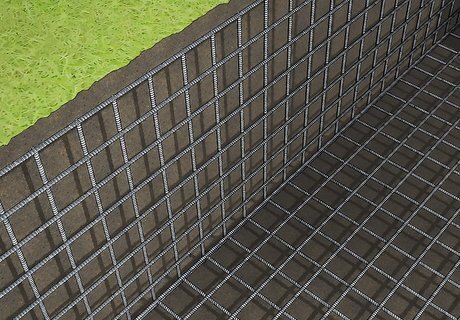
Frame the pool with steel rebar and plywood boards. Choose rebar rods about 0.625 in (1.59 cm) in diameter. Lay them along the pool’s interior in a crisscross pattern, spacing them out by 2 ⁄2 in (6.4 cm). Keep the rebar about 3 in (7.6 cm) above the soil. Then, stand ⁄2 in (1.3 cm)-thick plywood around the upper edge of the pool to prevent poured concrete from spilling out. Use a rebar bender to fit the metal along the walls. Bind bars together as needed with metal ties from a hardware store. The rebar forms a frame that strengthens the concrete after you pour it. Always place the rebar net before adding the concrete.
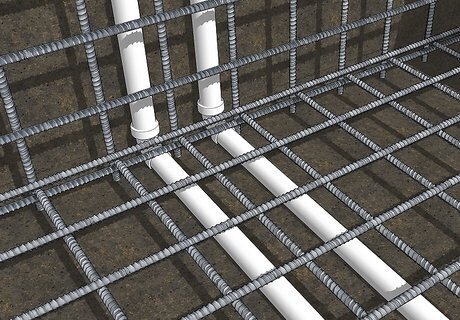
Install the plumbing lines underneath the rebar and plywood. Refer to your original design to figure out where to place the plumbing lines. You will need to dig trenches to guide PVC pipes from the pool to the pump and filtration system. Make the pipes emerge inside the pool, underneath the plywood barrier. Hook the pipes up to the pump and filter system when you’re done. Contract a plumber to take care of the water lines. Pool plumbing is complex and building codes vary from community to community. A good plumber will make sure your pool works safely.

Wire the pool’s filtration system and other electrical components. Call an experienced electrician to connect pool accessories to your community’s electrical grid. The electrician will lay wire from the pool’s pump and filtration system to your home. They will also hook up lighting systems and other optional components in your design. Leave the electrical work up to a professional. Messing with community power lines is illegal and dangerous. Poor wiring increases the risk of fires and electrical shock. Your pool contractor will run another set of PVC lines, which will be made of conduits to run the electrical system.
Completing the Pool’s Interior

Pour concrete into the pool to create the bottom slab. Purchase plenty of shotcrete mix or gunite. Place it all in a mixing truck equipped with a big hose or dumping rail. Dump the concrete onto the rebar or spray it out with a hose attached to the truck. Use enough concrete to make the pool floor at least 6 in (15 cm) thick. To make pouring the concrete easier, begin spraying the walls as you lay concrete on the floor so you don’t have to walk back and forth across the wet mix as much. Gunite is cement at 3,500 to 4,000 psi (24,000 to 28,000 kPa). It takes 28 days to cure.

Spray the walls to coat them with concrete. Put on some sturdy work boots you don’t mind getting wet, then step into the pool. Coat the walls to make a layer of concrete at least 6 in (15 cm) thick, Also, add concrete to the top lip of the pool marked off by plywood. Take care not to spray over any exposed pipe openings. Cap them and spray around them.
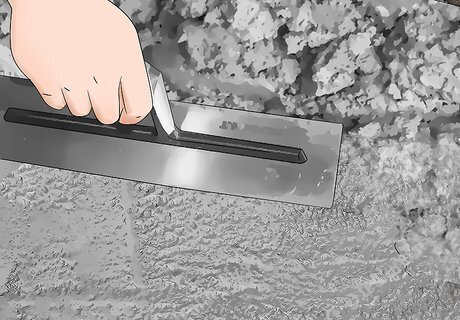
Smooth the concrete out with a concrete float. Step down into the pool to access the concrete slabs. You will need a float, which is like a big broom for concrete. Push the float over the floor to level it, then do the same for the walls. You can also use a big metal straightedge to smooth out difficult spots along walls and corners. The straightedge is also helpful for smoothing out steps into a block shape.
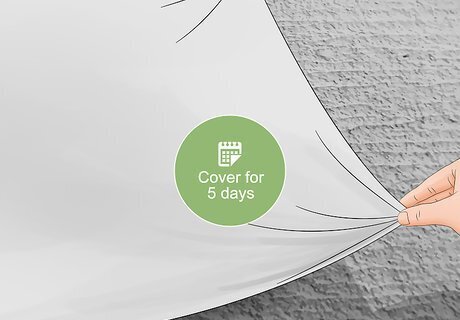
Cover the concrete with a plastic sheet for at least 5 days. For a long-lasting pool, let the concrete cure before continuing to work on it. Purchase a big plastic sheet from a hardware store. Make sure it covers the entire pool. Flatten it against the concrete, then pin it down with stakes, bricks, and other heavy objects. If you don’t have a good plastic cover, spray the concrete with water from a hose 3 or 4 times a day. Keep it saturated to prevent it from drying out. You can also place damp canvas or burlap over the concrete to protect it. Add water to the cover as needed to keep it moist.

Coat the pool basin with tile to waterproof it. Glass, ceramic, and porcelain tiles are some of the most popular ways to finish a pool. Mix mortar, then spread it over the concrete with a trowel. After waiting at least 24 hours, spread grout over the mortar. Place the tiles on the grout, leaving a ⁄8 in (0.32 cm) gap between each one. Leave a 6 in (15 cm) gap between the lip of the pool and the top row of tiles. Make sure the mortar and grout resist chlorine and other chemicals in the water. Tile lasts up to 10 years on average and resist stains better than other finishes, though it tends to be a little more expensive. Some other finishes to try include plaster, stone, or a water-resistant epoxy paint. Alternative finishes last 5 to 8 years on average. Expert Answer Q How should I plaster the bottom of the pool? Rob Litman Rob Litman Licensed Landscaper & General Contractor Rob Litman is a Landscaper, General Contractor, and the CEO of Vitoli Inc., a landscaping, hardscaping, ecoscaping, and swimming pool design company in Los Angeles, California. With over 20 years of experience in construction, Rob specializes in energy-efficient and drought-tolerant landscaping. He holds General Building Contractor (Class B) and Registered Pool/Spa Contractor Licenses. In 2007, Rob won House of the Year in Gardena, California. Rob Litman EXPERT ADVICE Answer from Rob Litman: You have 3 different plaster options: basic rubber plaster, a pebble mix, and a quartz hybrid. Choose your color scheme carefully if you go with the pebble mix, as the water will distort the color of the pebbles. For instance, if the bottom of your pool has gold pebbles, your pool water will look green. For this reason, try to avoid colors like orange, black, and brown.
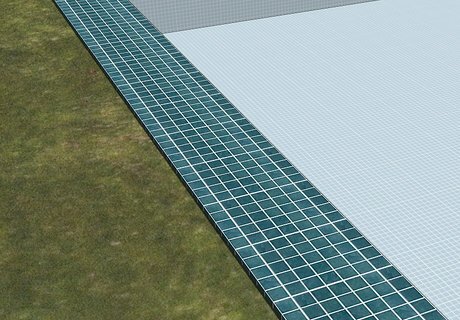
Install coping around the lip of the pool. Coping is visible and provides walking room around the pool’s edge. Tile is a common option, but you can also get concrete, marble, or stone. Each style adds a different aesthetic to your pool, but they all waterproof the exposed concrete. Wait at least 1 to 2 days for the tile and coping to cure before adding water to the pool. Install the coping with mortar and grout like you did when lining the pool’s interior. Cover the 6 in (15 cm) gap you left inside the pool, then arrange another row of coping material around the pool’s rim.
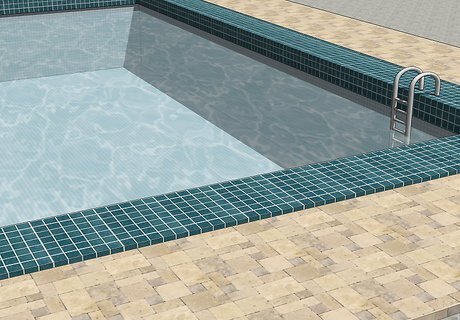
Fill the pool with water. You now have a concrete pool in your yard. All you need to do to make it functional is add the water. Run garden hoses from nearby water spigots to begin. Doing this takes a long time, so find alternative ways to bring in more water. Try renting a water truck to dump large amounts of water into the pool. If you can’t get a truck to the pool, continue using a hose. It may take all day, but with a little patience, you will soon have a functional pool. Watch the pool for leaks and other issues. Empty the pool before attempting a fix.


















Comments
0 comment